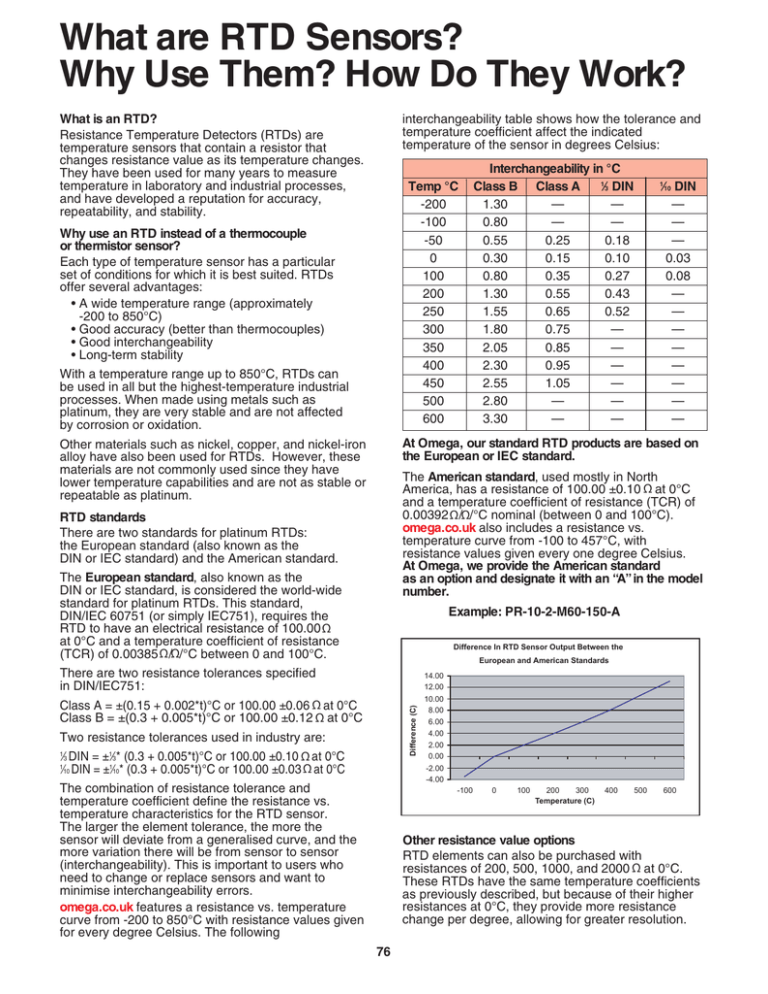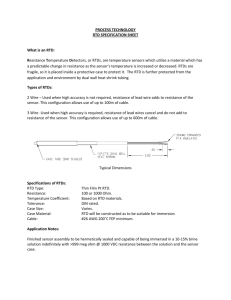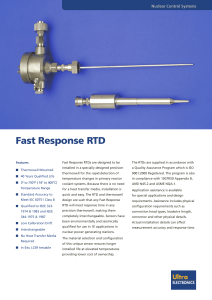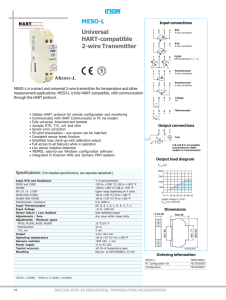76-79 Technical_REF.qxd_Layout 1 (Page 76)
advertisement

What are RTD Sensors?
Why Use Them? How Do They Work?
What is an RTD?
Resistance Temperature Detectors (RTDs) are
temperature sensors that contain a resistor that
changes resistance value as its temperature changes.
They have been used for many years to measure
temperature in laboratory and industrial processes,
and have developed a reputation for accuracy,
repeatability, and stability.
interchangeability table shows how the tolerance and
temperature coefficient affect the indicated
temperature of the sensor in degrees Celsius:
Temp °C
-200
-100
-50
0
100
200
250
300
350
400
450
500
600
Why use an RTD instead of a thermocouple
or thermistor sensor?
Each type of temperature sensor has a particular
set of conditions for which it is best suited. RTDs
offer several advantages:
• A wide temperature range (approximately
-200 to 850°C)
• Good accuracy (better than thermocouples)
• Good interchangeability
• Long-term stability
With a temperature range up to 850°C, RTDs can
be used in all but the highest-temperature industrial
processes. When made using metals such as
platinum, they are very stable and are not affected
by corrosion or oxidation.
Interchangeability in °C
1
Class B Class A
⁄3 DIN
1.30
—
—
0.80
—
—
0.55
0.25
0.18
0.30
0.15
0.10
0.80
0.35
0.27
1.30
0.55
0.43
1.55
0.65
0.52
1.80
0.75
—
2.05
0.85
—
2.30
0.95
—
2.55
1.05
—
2.80
—
—
3.30
—
—
⁄10 DIN
—
—
—
0.03
0.08
—
—
—
—
—
—
—
—
1
At Omega, our standard RTD products are based on
the European or IEC standard.
Other materials such as nickel, copper, and nickel-iron
alloy have also been used for RTDs. However, these
materials are not commonly used since they have
lower temperature capabilities and are not as stable or
repeatable as platinum.
The American standard, used mostly in North
America, has a resistance of 100.00 ±0.10 Ω at 0°C
and a temperature coefficient of resistance (TCR) of
0.00392 Ω /Ω/°C nominal (between 0 and 100°C).
omega.co.uk also includes a resistance vs.
temperature curve from -100 to 457°C, with
resistance values given every one degree Celsius.
At Omega, we provide the American standard
as an option and designate it with an “A” in the model
number.
RTD standards
There are two standards for platinum RTDs:
the European standard (also known as the
DIN or IEC standard) and the American standard.
The European standard, also known as the
DIN or IEC standard, is considered the world-wide
standard for platinum RTDs. This standard,
DIN/IEC 60751 (or simply IEC751), requires the
RTD to have an electrical resistance of 100.00 Ω
at 0°C and a temperature coefficient of resistance
(TCR) of 0.00385 Ω /Ω/°C between 0 and 100°C.
Example: PR-10-2-M60-150-A
Difference In RTD Sensor Output Between the
European and American Standards
There are two resistance tolerances specified
in DIN/IEC751:
Class A = ±(0.15 + 0.002*t)°C or 100.00 ±0.06 Ω at 0°C
Class B = ±(0.3 + 0.005*t)°C or 100.00 ±0.12 Ω at 0°C
Difference (C)
14.00
12.00
Two resistance tolerances used in industry are:
⁄3 DIN = ±1⁄3* (0.3 + 0.005*t)°C or 100.00 ±0.10 Ω at 0°C
1
⁄10 DIN = ±1⁄10* (0.3 + 0.005*t)°C or 100.00 ±0.03 Ω at 0°C
1
10.00
8.00
6.00
4.00
2.00
0.00
-2.00
-4.00
The combination of resistance tolerance and
temperature coefficient define the resistance vs.
temperature characteristics for the RTD sensor.
The larger the element tolerance, the more the
sensor will deviate from a generalised curve, and the
more variation there will be from sensor to sensor
(interchangeability). This is important to users who
need to change or replace sensors and want to
minimise interchangeability errors.
omega.co.uk features a resistance vs. temperature
curve from -200 to 850°C with resistance values given
for every degree Celsius. The following
-100
0
100
200
300
Temperature (C)
400
500
600
Other resistance value options
RTD elements can also be purchased with
resistances of 200, 500, 1000, and 2000 Ω at 0°C.
These RTDs have the same temperature coefficients
as previously described, but because of their higher
resistances at 0°C, they provide more resistance
change per degree, allowing for greater resolution.
76
)UHHSKRQH _ ,QWHUQDWLRQDO _
)D[
_ 6DOHV#RPHJDFRXN
ZZZRPHJDFRXN
81,7(' 67$7(6
ZZZRPHJDFRP
7&20(*$
6WDPIRUG &7
81,7(' .,1*'20
ZZZ RPHJDFRXN
0DQFKHVWHU (QJODQG
&$1$'$
ZZZRPHJDFD
/DYDO4XHEHF
7&20(*$
*(50$1<
ZZZRPHJDGH
'HFNHQSIURQQ *HUPDQ\
)5$1&(
ZZZRPHJDIU
%(1(/8;
ZZZRPHJDQO
More than 100,000 Products Available!
7HPSHUDWXUH
Calibrators, Connectors, General Test and Measurement
Instruments, Handheld Instruments for Temperature
Measurement, Ice Point References, Indicating Labels,
Crayons, Cements and Lacquers, Infrared Temperature
Measurement Instruments, Recorders, Relative Humidity
Measurement Instruments, PT100 Probes, PT100 Elements,
Temperature & Process Meters, Timers and Counters,
Temperature and Process Controllers and Power Switching
Devices, Thermistor Elements, Probes and Assemblies,
Thermocouples, Thermowells and Head and Well
Assemblies, Transmitters, Thermocouple Wire, RTD Probes
)ORZ DQG /HYHO
Air Velocity Indicators, Doppler Flowmeters, Level
Measurement, Magnetic Flowmeters, Mass Flowmeters,
Pitot Tubes, Pumps, Rotameters, Turbine and Paddle Wheel
Flowmeters, Ultrasonic Flowmeters, Valves, Variable Area
Flowmeters, Vortex Shedding Flowmeters
S+ DQG &RQGXFWLYLW\
Conductivity Instrumentation, Dissolved Oxygen
Instrumentation, Environmental Instrumentation, pH
Electrodes and Instruments, Water and Soil Analysis
Instrumentation
'DWD $FTXLVLWLRQ
Communication Products and Converters, Data
Acquisition and Analysis Software, Data Loggers
Plug-in Cards, Signal Conditioners, USB, RS232, RS485,
Ehernet and Parallel Port Data Acquisition Systems,
Wireless Transmitters and Receivers
3UHVVXUH 6WUDLQ DQG )RUFH
Displacement Transducers, Dynamic Measurement Force
Sensors, Instrumentation for Pressure and Strain
Measurements, Load Cells, Pressure Gauges, Pressure
Reference Section, Pressure Switches, Pressure Transducers,
Proximity Transducers, Regulators, Pressure Transmitters,
Strain Gauges, Torque Transducers, Valves
+HDWHUV
Band Heaters, Cartridge Heaters, Circulation Heaters,
Comfort Heaters, Controllers, Meters and Switching
Devices, Flexible Heaters, General Test and Measurement
Instruments, Heater Hook-up Wire, Heating Cable
Systems, Immersion Heaters, Process Air and Duct,
Heaters, Radiant Heaters, Strip Heaters, Tubular Heaters


